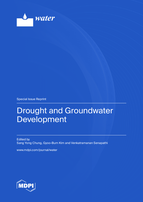Drought and Groundwater Development
A special issue of Water (ISSN 2073-4441). This special issue belongs to the section "Hydrology".
Deadline for manuscript submissions: closed (20 November 2022) | Viewed by 28846
Special Issue Editors
Interests: hydrogeology; geostatistics; artificial intelligence
Special Issues, Collections and Topics in MDPI journals
Interests: artificial recharge; artificial neural networks; groundwater monitoring
Interests: environmental geochemistry; hydrogeological processes; sediment dynamics; remote sensing and GIS; environmental toxins; microplastic
Special Issues, Collections and Topics in MDPI journals
Special Issue Information
Dear Colleagues,
Recently, climate change has become a very serious problem worldwide. Drought and flood frequently occur all over the world every year. This Special Issue deals with sustainable groundwater development against drought. The effective management of groundwater is also crucial to overcome drought. Artificial intelligence is a very useful tool for the effective management of groundwater. Artificial recharge has been a valuable countermeasure against drought in the past. However, artificial recharge is not easy to successfully implement everywhere due to the various geological conditions of aquifers.
In this Special Issue, we deal with many topics related to the sustainable development of groundwater against drought. We cordially invite colleagues to submit valuable manuscripts to this Issue.
Prof. Dr. Sang Yong Chung
Prof. Dr. Gyoo-Bum Kim
Dr. Venkatramanan Senapathi
Guest Editors
Manuscript Submission Information
Manuscripts should be submitted online at www.mdpi.com by registering and logging in to this website. Once you are registered, click here to go to the submission form. Manuscripts can be submitted until the deadline. All submissions that pass pre-check are peer-reviewed. Accepted papers will be published continuously in the journal (as soon as accepted) and will be listed together on the special issue website. Research articles, review articles as well as short communications are invited. For planned papers, a title and short abstract (about 100 words) can be sent to the Editorial Office for announcement on this website.
Submitted manuscripts should not have been published previously, nor be under consideration for publication elsewhere (except conference proceedings papers). All manuscripts are thoroughly refereed through a single-blind peer-review process. A guide for authors and other relevant information for submission of manuscripts is available on the Instructions for Authors page. Water is an international peer-reviewed open access semimonthly journal published by MDPI.
Please visit the Instructions for Authors page before submitting a manuscript. The Article Processing Charge (APC) for publication in this open access journal is 2600 CHF (Swiss Francs). Submitted papers should be well formatted and use good English. Authors may use MDPI's English editing service prior to publication or during author revisions.
Keywords
- sustainable development of groundwater against drought
- techniques of managed artificial recharge
- techniques of groundwater development in alluvium and bedrock
- numerical modelling for groundwater management
- improvement of groundwater quality
- health risk assessment of groundwater
- assessment of groundwater quality due to drought
- application of artificial intelligence to groundwater management








